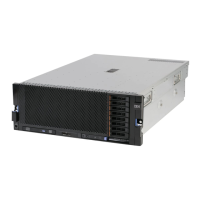f. Turn on all external devices.
g. Turn on the server. If the server does not start, see “Troubleshooting tables.”
h. Check the system-error LED on the operator information panel. If it is
flashing, check the light path diagnostics LEDs (see “Light path diagnostics”
on page 57).
i. Check for the following results:
v Successful completion of POST
v Successful completion of startup, which is indicated by a readable display
of the operating-system desktop
3. Is there a readable image on the monitor screen?
v No: Find the failure symptom in “Troubleshooting tables”; if necessary, see
“Solving undetermined problems” on page 77.
v Yes: Run DSA (see “IBM Dynamic System Analysis” on page 71).
– If DSA reports an error, follow the instructions in Appendix A, “DSA
diagnostic test results,” on page 227.
– If DSA does not report an error but you still suspect a problem, see
“Solving undetermined problems” on page 77.
Troubleshooting tables
This topic contains troubleshooting tables to help find solutions to problems with
symptoms.
About this task
Use the troubleshooting tables to find solutions to problems that have identifiable
symptoms.
If you cannot find a problem in these tables, see “IBM Dynamic System Analysis”
on page 71 for information about testing the server.
If you have just added new software or a new optional device and the server is
not working, complete the following steps before you use the troubleshooting
tables:
Procedure
1. Check the light path diagnostics LEDs on the operator information panel (see
“Light path diagnostics” on page 57).
2. Remove the software or device that you just added.
3. Run IBM Dynamic System Analysis (DSA) to determine whether the server is
running correctly (for information about using DSA, see “IBM Dynamic System
Analysis” on page 71).
4. Reinstall the new software or new device.
Results
42 IBM System x3850 X5 and x3950 X5 Types 7145, 7146, 7143, and 7191: Problem Determination and Service Guide

